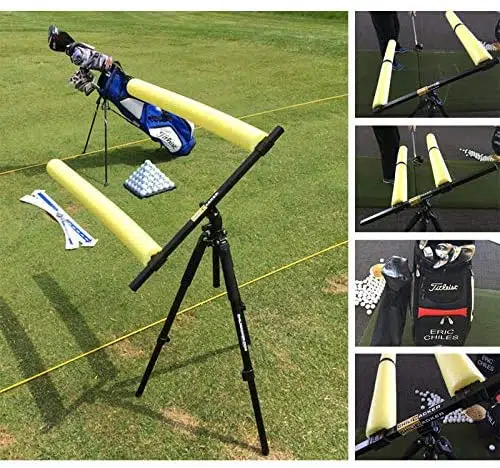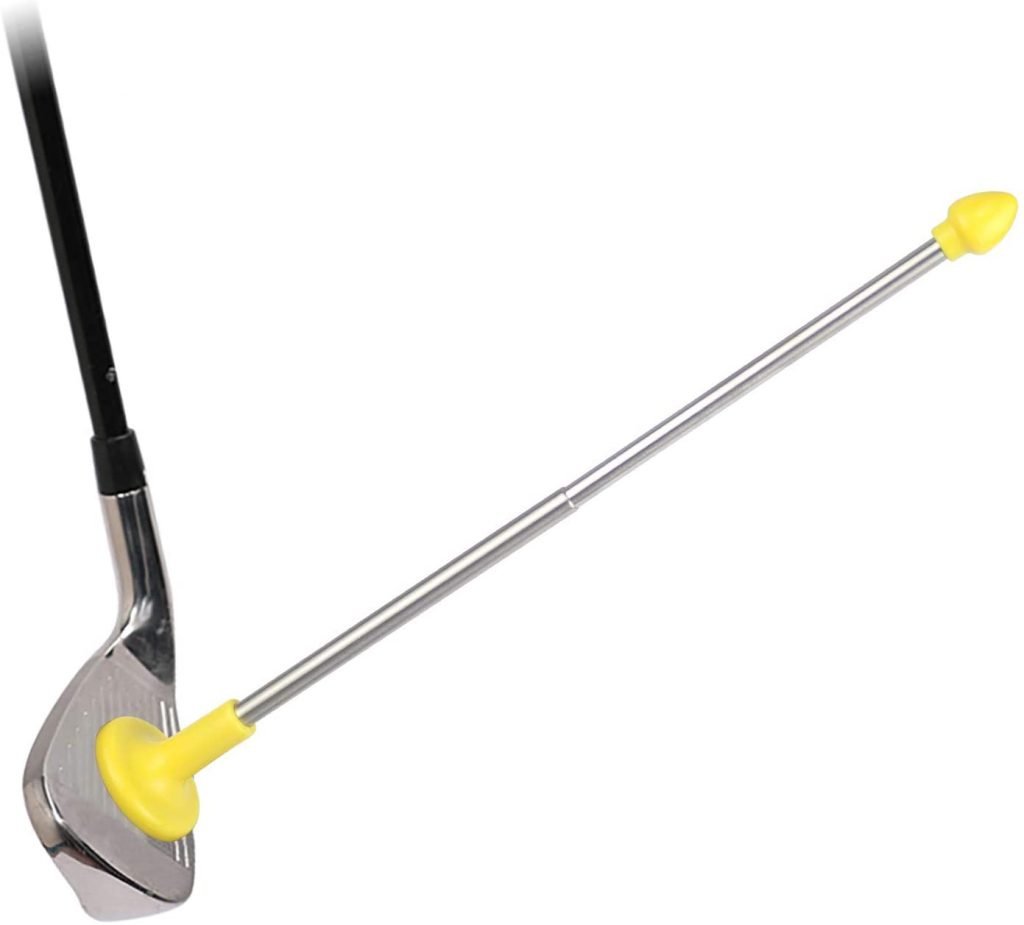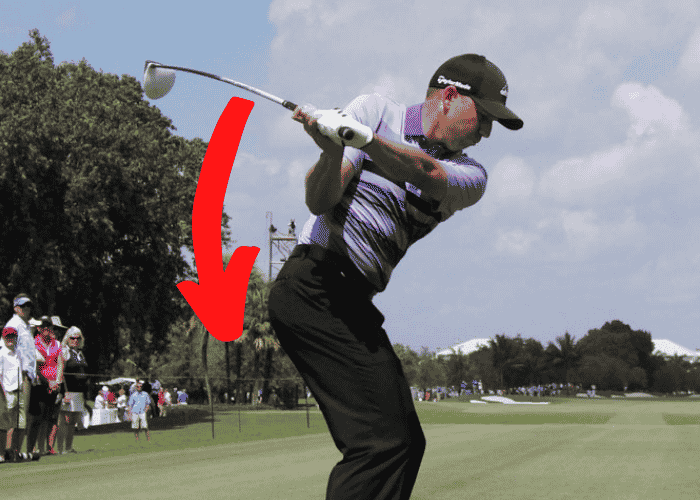Shallowing the club in the golf swing is something many amateurs know they must do, but often struggle to achieve despite endless lessons and hours spent trawling YouTube.
It is an elusive movement that is mastered by so few, yet offers some of the best flow-on effects and results that can take your swing to the next level.
It’s all to do with reducing how steep the club is in the backswing, a point of the swing where everything is transitioning quite quickly and can be hard to keep track of.
It’s also an unnatural feeling for many, especially for slicers of the ball, so can be a hard habit to break.
However, despite the challenge of this movement, it’s something that is common to practically every golfer on the PGA and European Tours – the standard everyone, albeit unrealistically, aspires to.
But hey, if you want to get better at golf, it probably makes sense that trying to copy the best in the world might pay dividends.
Let’s explore the elusive movement that is shallowing the golf club and crack the code on how to incorporate it into your own swing.
Table of contents
What does shallowing the golf club mean?
Shallowing the golf club refers to a movement at the top of the backswing where the club shifts from a ‘steep’ position to a ‘shallower’ position, resulting in a shaft angle more horizontal to the ground. When shallowing the golf club correctly, your trail arm and wrists will help the downswing occur underneath the plane that the club was on at the top of the swing.
The best way to see how the club is supposed to shallow during your golf swing is by looking at a video of a pro with tracing lines drawn along the club shaft at the top of their swing.
If, straight after the completion of the backswing, the club transitions into the downswing at an angle shallower than at the top of the backswing, that player has effectively shallowed the club.
Next time you’re hitting balls at home on your practice net or at the driving range, try filming your own swing and compare how your club moves in the downswing compared to the pros (read here for a guide on how to record it).
To help viewers and average golfers visualise how the club shallows, the PGA Tour has added an excellent feature to their coverage where green and red lines show the exact components of a pro’s golf swing, broken into the backswing and the downswing.
The one thing that is unbelievably common in the video above is, no matter how steep the backswing, practically every player will transition the club into the downswing at a shallower angle, even if only slightly, and arrive at a nearly identical impact position.
Even a player with a swing as remarkably unique as Matthew Wolff – who takes the club practically straight up in the air – shallows the club monumentally in the downswing. If he didn’t do this, his swing would be extremely ineffective.
How do you shallow the golf club?
To shallow the golf club, you need to use the trail arm and wrists to move the club shaft from a steep position to a shallow position, more horizontal to the ground. By dropping the trail arm and hinging the wrists at the top of the swing, this will cause the club to fall into a ‘shallower’ position.
One thing to be wary of is using the body to drop the club into a shallower position through unnatural or awkward motions.
It is possible to sway off the ball and stand up in the swing to try and get the club into the desired slot, but this will cause all sorts of other issues in your swing that will just make it harder to make good contact.
A good video from Chris Ryan Golf (click here to watch it on YouTube) discusses the dos and don’ts of shallowing the golf club, as well as demonstrates a drill that will help you find the desired feeling. I’ll summarise it below.
Use the split hands drill to shallow the club
To perform this drill, all you need is two simple steps. They are:
- Split your hands on the golf club so the trail arm (right arm for a right hander) sits a long way down the shaft
- At the top of your swing, practice pulling that right arm downwards into the slot (around a 45 degree angle to your target line) to flatten out the club
- Repeat this ‘pumping’ motion to get the feeling of shallowing the club into the correct position
Now, it might feel like this is silly given you don’t swing the club this way, but trying to develop an overaccentuated feel in practice will hopefully lead to a desirable middle ground when implementing this in your actual swing.
The ‘pulling down’ analogy is a really good one, given it is the exact swing thought of one of the best in the world at shallowing the golf club: Spaniard Sergio Garcia.
Sergio learned the art of shallowing the golf club through the analogy of ‘pulling down on a chain’ with his trail hand to get the golf club shallower, which has led to him becoming one of the best ball-strikers in the game.
Top training aids for shallowing the golf club
Often a training aid is going to be a huge help in replicating the movement required to shallow the golf club in the downswing.
Many of these aids are fantastic, offering real-time feedback on the success of your attempts to shallow the club.
Here are our top three training aids to help you shallow your swing correctly and start grooving the correct motion.
1. Chiliwacker Golf Swing Training Aid

If you are having difficulty shallowing the club, it’s likely due to an over-the-top downswing, causing a slice.
The Chiliwacker Training Aid allows you to arrange foam guides that align your swing on the correct plane (more inside if you are trying to shallow the club).
If you strike the foam guides (as demonstrated in this video) you’ve come off plane and can adjust your swing accordingly, with no damage to your club.
2. Shaun Webb Golf Alignment Sticks
Simple, cheap, yet highly effective, alignment sticks are the most versatile of all training aids.
Set up an alignment stick just outside and behind the line of your club shaft at address and ensure you don’t make contact with it on the way down.
If you do, you’re coming over the top, and can practice coming more inside to miss the stick and shallow the club.
3. TuhooMall Magnetic Golf Club Alignment Stick

Before embarking on a journey to shallow the golf club, it is important to determine whether other factors, such as an open clubface, are actually the cause of your slicing, rather than your club path.
These simple yet effective TuhooMall Magnetic Alignment Sticks will attach to your clubface and, with a few slow swings, identify where your club is pointing at impact.
How do you shallow the golf club and hit it farther?
To shallow the golf club and hit the ball farther it is important to flatten the club in the backswing, not steepen it. Getting the club in a more horizontal position will allow you to coil and release more freely, maintain swing speed and avoid slices that will travel far less distance than draws.
As Clay Ballard of Top Speed Golf explains, if you come ‘over-the-top’ and have a downswing as steep as, if not steeper than, your backswing, it’s a recipe for striking the ground way before the ball.
To counter this, people make a whole range of adjustments as their brain knows this is where the club is headed, such as early extension or rising up out of the swing.
All of these actions are problematic for a number of reasons, especially if you are looking to get the most distance out of your swing.
An early extension or rising of the body to re-route the golf club causes a slowing of the downswing.
A reduction in swing speed is going to reduce the energy imparted on the golf ball, leading to shorter distance.
The other reason to work on a shallower club is to negate over the top swings that cause ballooning slices that perform poorly, rather than a nice, penetrating fade.
Generally, slicing shots don’t travel as far as a draw, and a shallower club will come more from the inside, meaning a draw, rather than a slice, is more likely.
Why can’t I shallow the golf club?
You might not be able to shallow the club due to a strong grip or a takeaway that is too far on the inside. A strong grip will make it harder for you to perform the necessary wrist adjustments at the top of the swing and an inside takeaway will cause your backswing to be too shallow, meaning shallowing even further can cause hooks.
As you transition from the backswing into the downswing, one of the feels you should be looking for is that the wrists hinge and cause the right palm to face more towards the sky. A strong grip, or even poor wrist flexibility, will hinder this.
The other thing to look out for is an inside takeaway. If you’re too far inside when taking the golf club back, you’ll bring the club into a naturally shallow position.
Your brain can tell that this position won’t realign with the ball on the downswing, so your tendency will be to steepen the club in the downswing to counteract this.
It is important to work on a takeaway that is less on the inside so that the club is steeper at the top of the swing.
This will mean you can feel confident about shallowing the club to get in a better position.
How do you flatten a golf swing?
To flatten the golf swing you need to work on taking the club into a position more horizontal to the ground at the top of the swing. This can be achieved by dropping the trail arm and allowing the wrists to lower the club head more towards the ground.
It is important that this action comes from the wrists and the trail arm, not a movement of the body, as this can just cause further issues in your swing.
Use the wall drill to flatten your swing
A great drill to practice this is the wall drill. Here’s how you do it:
- Simply set-up as you normally would at address with your back to a wall (it’s best to do this outside as you don’t want to scrape paint off your living room wall)
- Next, take your club to the top of your backswing until it comes into contact with the wall behind you
- As you slowly begin the motion of your downswing, keep your clubhead sliding down the wall (maintaining contact) until your club is nearly parallel with the ground
This drill should give you the sensation of the club lagging behind you, rather than steepening, which if practiced regularly will help flatten your swing.
Can a golf swing be too shallow?
Yes, a golf swing can be too shallow, and people who take the club back in a shallow position will quite often come over-the-top to negate this, leading to slices and misses to the right. Try working on a takeaway less from the inside, and more on-plane, so you can shallow the club with confidence.
If a swing is too shallow, then the result will likely be a hook due to the extreme in-to-out path.
For many people, however, the opposite occurs as they will make drastic over-the-top movements to negate the shallow angle.
Coming over the top will, unfortunately, lead to a slice.
The best thing to aim for is a steeper club, or higher hands, at the top of the backswing that becomes a shallower club on the downswing.
PGA Tour player Matthew Wolff is a perfect example of how it doesn’t really matter how steep the backswing is, so long as it is shallowed far enough in the downswing and arrives at the correct impact position.
Final message
Many people play golf for decades with weird actions in their swing and several faults adequately patched up by counteracting movements and fixes.
While this will get you so far, it’s hard to ignore certain things that every pro does if you want to get down into those really low numbers.
If you really want to drop that handicap and start hitting it flush, get out on the range and start putting in the work to shallow that club today and improve your ball-striking.
- TaylorMade SIM2 Max Driver vs M4 Driver: Worth it in 2024? - April 15, 2024
- 3 Ways to Win the Mental Game with the Bridgestone Mindset Golf Ball - March 29, 2024
- TaylorMade SIM Max & SIM2 Max Drivers: Are they Still Relevant in 2024? - March 9, 2024


